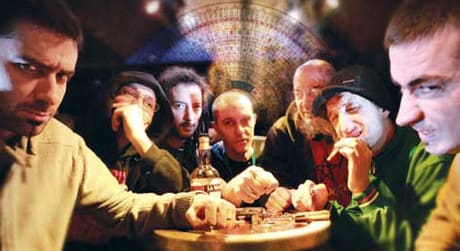So why is reggae and dub at a jazz festival anyways? Funk, soul and blues all make sense, but Jamaican sounds have crept into a few Artistic Directors' programming. Certainly the Jamaican aesthetic resonates more deeply with jazz musicians and fans than it used to — possibly because the level of musicianship in most reggae bands has gone way up over the years, or maybe roots reggae is prime dad music like the rest of the fest's offerings. On a Saturday night at Metropolis, High Tone and Face T assembled a crowd of several hundred of some of the younger end of the jazz fest demographic for a double shot of Franco-reggae.
Face T has now earned veteran status in Montreal. He's been around for over ten years and is quite a decent songwriter, as evidenced by his consistently hummable choruses. His current band is pretty fresh to him, if not to the reggae scene in Montreal, and despite only having rehearsed with him a few times, left a solid impression with several moments of inspiration, as with their rework of Face T's best known song, "Wha-La-La Leng." He's a seasoned performer, definitely one of Canada's best contemporary reggae artists. He could open up for any touring act, whether roots, or in tonight's case, tech-heavy. Though Face T's voice was agreeably rough and rugged he began to tire just before his set was over. He knew when to quit.
Lyon's High Tone have been kicking for well over a decade, and have made a reputation as one of the most futuristic dub bands out there. The problem with being known as futurists is that you have to keep innovating, and this show felt a bit behind the times. In a way, it was symbolic of how dubstep's aggressive, unforgiving bass has made traditional dub artists sound smaller. Not that High Tone were ever traditional, but their Jamaican leanings seem pushed back even further these days — now it's mostly heavy, rock-ish beats and vacuum-cleaner keyboard noises. The supple melodies of reggae bass lines were often bludgeoned into ugly monotonous pulses while booming drums sounded as though Led Zeppelin's "When The Levee Breaks" was just a jumping-off point.
Gradually the soundman found the handle and what had been a difficult-to-distinguish morass of digital sounds. The highlight of their set was actually visual, with perfectly synced video content bringing rappers-ex-machina to drive the band. However, Bollywood vocal cut-ups are a technique that has not aged well over the years; High Tone's "ethno-dub" notions feel more uncomfortable than they did 15 years ago. All in all, it was a decent but somewhat monotonous set.
Face T has now earned veteran status in Montreal. He's been around for over ten years and is quite a decent songwriter, as evidenced by his consistently hummable choruses. His current band is pretty fresh to him, if not to the reggae scene in Montreal, and despite only having rehearsed with him a few times, left a solid impression with several moments of inspiration, as with their rework of Face T's best known song, "Wha-La-La Leng." He's a seasoned performer, definitely one of Canada's best contemporary reggae artists. He could open up for any touring act, whether roots, or in tonight's case, tech-heavy. Though Face T's voice was agreeably rough and rugged he began to tire just before his set was over. He knew when to quit.
Lyon's High Tone have been kicking for well over a decade, and have made a reputation as one of the most futuristic dub bands out there. The problem with being known as futurists is that you have to keep innovating, and this show felt a bit behind the times. In a way, it was symbolic of how dubstep's aggressive, unforgiving bass has made traditional dub artists sound smaller. Not that High Tone were ever traditional, but their Jamaican leanings seem pushed back even further these days — now it's mostly heavy, rock-ish beats and vacuum-cleaner keyboard noises. The supple melodies of reggae bass lines were often bludgeoned into ugly monotonous pulses while booming drums sounded as though Led Zeppelin's "When The Levee Breaks" was just a jumping-off point.
Gradually the soundman found the handle and what had been a difficult-to-distinguish morass of digital sounds. The highlight of their set was actually visual, with perfectly synced video content bringing rappers-ex-machina to drive the band. However, Bollywood vocal cut-ups are a technique that has not aged well over the years; High Tone's "ethno-dub" notions feel more uncomfortable than they did 15 years ago. All in all, it was a decent but somewhat monotonous set.
